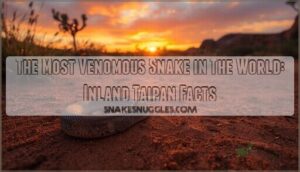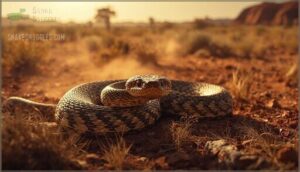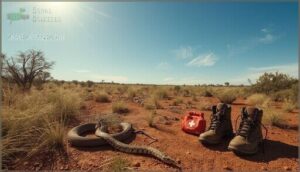This site is supported by our readers. We may earn a commission, at no cost to you, if you purchase through links.

This paradox stems from its remote habitat in Australia’s arid interior and its remarkably docile temperament. Understanding what makes this species so extraordinarily venomous—from its neurotoxin-hemotoxin cocktail to its evolutionary adaptations—reveals how nature engineered the perfect biochemical weapon while tempering it with an unexpectedly gentle disposition.
Table Of Contents
- Key Takeaways
- What Defines a Venomous Snake?
- The Inland Taipan: World’s Most Venomous Snake
- Venom Composition and Lethality
- Geographic Range and Natural Habitat
- Symptoms and Effects of Inland Taipan Bites
- Comparing Other Highly Venomous Snakes
- Preventing and Treating Venomous Snake Bites
- Conservation and Ecological Importance
- Frequently Asked Questions (FAQs)
- What is the most venomous snake in Australia?
- What is the longest venomous snake in the world?
- What is the deadliest snake in the world?
- What is the most venomous snake?
- Which countries have the most venomous snakes?
- How many snakes are venomous?
- What is the 1 deadliest snake in the world?
- What are the top 3 poisonous snakes?
- Which snake venom kills the fastest?
- Is the black mamba the deadliest snake in the world?
- Conclusion
Key Takeaways
- The inland taipan produces venom with an LD50 of 0.025 mg/kg—roughly 50 times more lethal than a cobra’s—yet its remote desert habitat and docile temperament mean it has never caused a recorded human death.
- This snake’s venom contains a sophisticated cocktail of neurotoxins, hemotoxins, and myotoxins working simultaneously to paralyze the nervous system, destroy blood clotting factors, and break down muscle tissue within 45 minutes of envenomation.
- While the inland taipan ranks as the world’s most venomous land snake by toxicity, the saw-scaled viper causes far more human fatalities globally due to its aggressive nature and proximity to populated areas.
- Prompt administration of taipan-specific antivenom shows 92% recovery rates, but global access remains severely limited—treatment costs exceed $31,000 in the U.S., and 57% of sub-Saharan medical facilities face persistent shortages.
What Defines a Venomous Snake?
You might hear ‘venomous’ and ‘poisonous’ used interchangeably, but they’re not the same thing regarding snakes.
Understanding how venom works—and how we measure its danger—helps you grasp what makes certain species so deadly.
Let’s break down the key differences and the science behind venom toxicity.
Venom Vs. Poison Explained
You might think venom and poison are the same, but the difference comes down to delivery. Venom requires injection through a bite or sting—think of it as an active weapon used by venomous snakes with specialized fangs. Poison, meanwhile, works passively when you touch, inhale, or swallow it.
Here’s what sets them apart:
- Venom Delivery: Injected through wounds using anatomical structures like fangs, causing rapid physiological effects through envenomation
- Poison Types: Absorbed through skin contact, ingestion, or inhalation without breaking the skin
- Toxicity Levels: Venom contains complex protein mixtures targeting specific tissues; poisons vary widely in chemical composition
- Snake Behavior: Venomous snakes actively hunt or defend using targeted toxin delivery for immediate incapacitation
Understanding the differences between venom and poison is essential, and learning about venom types can provide valuable insights into their complex mechanisms.
This distinction matters for reptile venom research and toxicology—understanding toxin studies helps us develop better treatments and respect these extraordinary creatures’ role in nature.
Types of Snake Venom (Neurotoxic, Hemotoxic, Cytotoxic)
Snake venom falls into three main categories, each targeting different systems in your body. Neurotoxic venoms, like those from the inland taipan and black mamba, attack your nervous system by blocking neurotransmission—leading to paralysis and respiratory failure with LD50 values around 0.2-0.4 mg/kg. Hemotoxic venoms destroy red blood cells and disrupt clotting, causing hemorrhage or thrombosis. Cytotoxic venoms trigger localized cell death and tissue necrosis at the bite site, with systemic effects spreading through damaged vascular pathways.
Understanding the effects of snake venom composition is vital for developing effective treatments.
Measuring Venom Toxicity (LD50 and Other Metrics)
When scientists assess venom potency, they rely primarily on LD50 values—the dose that kills 50% of test animals, usually mice. The inland taipan holds the record with an LD50 as low as 0.01 mg/kg via subcutaneous injection, making it the most venomous snake by this toxicology standard. However, variability in toxicity tests exists due to animal strain differences and environmental factors.
Modern venom research now incorporates in vitro assays and ELISA techniques, offering more precise venom metrics without relying solely on animal testing.
The Inland Taipan: World’s Most Venomous Snake
The inland taipan holds an undisputed title as the world’s most venomous snake, a distinction rooted in scientific measurement rather than myth.
Understanding this elusive reptile begins with examining its classification, the history of its discovery, and the physical traits that set it apart from other serpents.
Let’s explore what makes this Australian species so remarkable.
Scientific Classification and Common Names
When you’re tracking venomous snake species, understanding taxonomic hierarchy becomes essential. The inland taipan—scientifically named Oxyuranus microlepidotus—belongs to the family Elapidae. This genus name translates to “sharp arch,” referencing its unique palate structure.
Indigenous Australians call it “dandarabilla,” though you’ll often hear “fierce snake,” a name highlighting its lethal venom rather than temperament. Classification systems place it within three recognized Oxyuranus species, each defined by distinct genus characteristics and nomenclature history.
Discovery and Historical Context
In early explorations of Australia, the Inland Taipan lingered in the shadow of misconception and taxonomic debates. Indigenous knowledge quietly guided initial encounters, long before Western science grasped the truth.
With decades of silence after its first documentation, only persistent rediscovery efforts in the 1970s reopened toxicology and venom research—and shaped modern wildlife conservation and protection strategies for venomous snakes.
Unique Physical Characteristics
When you examine an Inland Taipan, you’ll notice how seasonal shifts profoundly alter its appearance. The snake’s body shape is slender yet sturdy, usually 1.8 meters long, with smooth, glossy scales lacking keels. Head morphology reveals a rectangular shape—broader than the neck—with large dark eyes and fangs measuring 3.5 to 6.2 millimeters. Color adaptation is striking: darker brown or black tones in winter absorb heat, while pale fawn hues in summer reflect sunlight. Scale patterns display distinctive dark-edged scales forming broken herringbone chevrons along the dorsum, contrasting with yellowish ventral surfaces.
Key identifying features:
- Seasonal coloration shifts – Dark brown to black in winter transitions to pale yellowish-brown in summer, enabling thermoregulation in desert environments.
- Distinctive scale arrangement – Twenty-three midbody dorsal scale rows with smooth texture and characteristic dark-edged chevron patterns aid camouflage.
- Specialized head structure – Rectangular head with proportionally large eyes and short fangs optimized for rapid, precise venom delivery during strikes.
These adaptations reflect reptile ecology principles, where snake behavior and habitat demands shape physical traits. Understanding venom delivery mechanisms and morphological features helps you appreciate why this species remains both fascinating and formidable among venomous snakes in zoology and herpetology studies.
Venom Composition and Lethality
The inland taipan’s venom isn’t just potent—it’s a carefully orchestrated weapon that transforms tissue and blood with terrifying efficiency. Understanding what makes this venom so deadly requires looking at three key elements: its measurable toxicity, the specific compounds that attack your body’s systems, and the enzymes that guarantee rapid delivery.
Let’s break down exactly what happens when this venom enters the bloodstream.
Potency and LD50 Values
When you examine the inland taipan’s venom potency, you’re looking at record-breaking numbers. LD50 testing in mice reveals subcutaneous values as low as 0.025 mg/kg—some studies report 0.01 mg/kg. These enzyme effects accelerate absorption, making toxin composition deadlier. Snake venom potency factors combine with yield: one bite delivers 44-110 mg, theoretically lethal to 100 humans.
| Snake Species | LD50 Value (mg/kg) | Relative Toxicity |
|---|---|---|
| Inland Taipan | 0.01–0.025 (subcutaneous) | Most potent land snake |
| Coastal Taipan | 0.064–0.099 (subcutaneous) | Less toxic than inland |
| Black Mamba | Higher than inland taipan | Much less potent |
| Saw-Scaled Viper | ~0.57 (intravenous) | Much lower potency |
Key Toxins and Their Effects
When inland taipan venom enters your bloodstream, you’re facing a lethal cocktail targeting multiple organ systems simultaneously. The venom composition includes neurotoxins like paradoxin and postsynaptic alpha-toxins causing rapid paralysis, hemotoxins triggering defibrination and hemorrhaging, and myotoxins destroying muscle tissue. Understanding these toxin delivery mechanisms reveals why snake bites from this species demand immediate medical intervention.
- Neurotoxin effects: Presynaptic and postsynaptic toxins block nerve signaling, causing descending paralysis, ptosis, and respiratory failure within 45 minutes
- Hemotoxic activity: Procoagulants consume clotting factors, creating nonclottable blood and internal hemorrhaging, especially cerebral bleeding
- Myotoxin damage: Rhabdomyolysis breaks down muscle cells, releasing myoglobin that causes reddish-brown urine and acute kidney failure
- Multi-system poisoning: Combined toxicity levels overwhelm nervous, circulatory, muscular, and renal systems simultaneously, explaining the inland taipan’s unparalleled lethality among venomous snakes
Enzymes Accelerating Venom Absorption
Beyond delivering toxins, inland taipan venom contains specialized enzymes that act like biochemical battering rams. Hyaluronidase breaks down tissue barriers, while phospholipase A2 destabilizes cell membranes—enzyme synergism that accelerates venom diffusion through your body.
Proteolytic enzymes degrade collagen matrices, enabling rapid toxin penetration. These toxicity mechanisms create a multi-phasic absorption profile in snake bites, with studies showing over 80% bioavailability.
This enzymatic acceleration distinguishes the inland taipan in toxin studies and research, making it a critical subject in toxicology and venom analysis among venomous snakes.
Geographic Range and Natural Habitat
You won’t find the inland taipan just anywhere—this serpent calls one of the planet’s harshest landscapes home. Understanding where it lives and how it survives there reveals why encounters with humans remain so rare.
Let’s explore the territories this elusive predator inhabits and the extraordinary ways it’s adapted to thrive in such unforgiving conditions.
Central Australian Distribution
You’ll find the Inland Taipan in Australia’s most unforgiving terrain—the semiarid black soil plains where Queensland, South Australia, and the Northern Territory meet. This venomous snake inhabits the Channel Country’s remote landscapes, seeking shelter in deep soil cracks that split the arid ecosystems.
Geographic isolation defines its range, with sparse populations near Coober Pedy and historical records from northwestern Victoria, though reptile ecology studies confirm it’s now extinct there.
These desert habitats remain sparsely populated, making wildlife conservation efforts challenging yet essential.
Preferred Desert and Grassland Environments
You’ll encounter this species in landscapes where cracked black soils and clay loams dominate—terrain that provides essential shelter through deep fissures and abandoned rodent burrows. Desert ecology shapes these grassland habitats, where sparse vegetation like chenopod shrubs creates open hunting grounds.
- Cracking clays and loams offer critical shelter types in soil crevices
- Gibber plains and floodplains with minimal vegetation support prey populations
- Rocky outcrops provide microhabitats for thermoregulation
- Seasonal rainfall influences rodent abundance and ecosystem balance
These venomous snakes thrive where extreme heat demands underground refuge, maintaining their role in reptile ecology and biology through specialized soil preferences.
Behavioral Adaptations to Habitat
These venomous snakes adjust their hunting and sheltering behaviors to survive harsh desert conditions. Thermoregulation drives their daily rhythm—you’ll find them basking on rocks during cooler months to boost metabolic function and venom efficacy, then switching to crepuscular activity when temperatures soar.
Habitat selection centers on rodent burrows and soil crevices, where they employ ambush hunting strategies and avoid predators while maintaining ideal body temperature for reptile ecology and biology.
Symptoms and Effects of Inland Taipan Bites
When an inland taipan strikes, its venom triggers a cascade of life-threatening effects that demand immediate attention. Understanding these symptoms can mean the difference between survival and tragedy.
Let’s examine what happens to your body after a bite, from the first warning signs to the potential complications that can linger long after treatment.
Immediate Physiological Reactions
When an inland taipan strikes, its neurotoxin effects trigger immediate physiological responses you need to recognize. Within minutes, you’ll notice severe pain and swelling at the bite site, often accompanied by headache, nausea, vomiting, and dizziness.
The venom absorption accelerates rapidly due to specialized enzymes, and collapse or convulsions may occur within 30 to 45 minutes as toxicity levels overwhelm your system—making emergency interventions absolutely critical.
Progression of Envenomation
As envenomation symptoms progress, you’ll experience venom spread through both your lymphatic and circulatory systems within the first hour. Toxicity levels peak rapidly—between 15 and 30 minutes—as the inland taipan’s metalloproteinases and phospholipases trigger coagulopathies and tissue breakdown. Your body shows a biphasic pattern: initial rapid distribution followed by slower elimination, with venom absorption continuing for hours.
Without snakebite treatment, neurotoxicity intensifies, leading to respiratory failure and cardiovascular collapse—underscoring why snake bite prevention and treatment through prompt antivenom administration is critical in reptile toxicology.
Long-Term Health Complications
Even with prompt treatment, you may face lasting organ damage, neurological effects, and chronic pain that persist for months. Inland Taipan bites can trigger acute kidney injury, sometimes progressing to long-term dialysis requirements, while neurotoxins disrupt nerve function for weeks or longer.
Rehabilitation outcomes vary—about 25% of survivors need one to nine months to recover fully—and psychological trauma compounds physical disabilities, highlighting why snake bite prevention and treatment remain critical in toxicology.
Comparing Other Highly Venomous Snakes
While the inland taipan holds the crown for venom toxicity, you’ll find several other species that pose significant threats to human life. Each brings its own lethal combination of venom composition, delivery method, and behavioral patterns that make them formidable in different ways.
Let’s compare how these deadly serpents stack up against the inland taipan.
Black Mamba Vs. Inland Taipan
You might wonder whether raw toxicity or aggressive behavior makes a snake more dangerous. In snake venom comparison, the Inland Taipan wins on potency—its LD50 of 0.025 mg/kg versus the Black Mamba’s 0.32 mg/kg makes it far deadlier per milligram.
However, deadly bite effects tell a different story. Black Mambas deliver up to 400 mg of venom with aggressive snake attack strategies, enough to kill 20 humans, while Inland Taipans inject smaller volumes from their desert habitat.
The King Cobra can’t match either’s toxicity, though all venomous snakes demand respect despite varying venom immunity factors among prey species.
Saw-Scaled Viper and Human Fatalities
Unlike the Inland Taipan’s remote habitat, the Saw-Scaled Viper thrives near human settlements, causing 5,000 to 30,000 snakebite deaths annually across Africa and Asia. Rural mortality rates climb to 20% when antivenom shortages strike, especially in India’s agricultural zones.
Fatal bite statistics reveal 98% of victims develop uncontrolled bleeding, while viper habitat loss pushes these venomous snakes closer to homes.
Snake bite prevention remains challenging—88% of snake bites occur at night on lower limbs, making antivenom access critical for survival.
Blue Malayan Coral Snake and Others
You’ll find tropical snake species like the Blue Malayan Coral Snake deliver venom faster than the Inland Taipan through unique sodium channel disruption. Its LD50 of 0.81 μg/g in mice surpasses most deadly snake encounters, though snake bites remain rare in coral snake habitats across Southeast Asia’s lowland forests.
Snake venom evolution has refined venomous snake behaviors—this species hunts other venomous snakes using pre-synaptic toxins, demonstrating specialized venomous animal encounters few serpents match.
Preventing and Treating Venomous Snake Bites
While the inland taipan carries the world’s deadliest venom, you won’t likely encounter one in the wild—but knowing how to prevent and respond to any venomous snake bite can save your life. Understanding basic safety measures, proper first aid techniques, and treatment options transforms fear into informed confidence.
Let’s examine three essential aspects of protecting yourself and responding effectively if a bite occurs.
Bite Prevention Strategies
You can dramatically reduce your risk of venomous snake bites, including encounters with the Inland Taipan, by combining protective gear with environmental awareness. Safe hiking means wearing high leather boots and snake-proof gaiters—key defenses against fangs targeting your lower legs.
Consider these evidence-based strategies for snakebite prevention:
- Keep grass short and remove brush piles to eliminate snake hiding spots near your home
- Use a flashlight during night walks, as many venomous snakes become more active after dark
- Shake out boots and sleeping bags before use to dislodge any hidden snakes
- Never handle snakes, even dead ones—reflexive bites can still occur from detached heads
- Carry emergency kits and a charged phone when hiking in areas where antivenom access matters
Awareness programs in rural communities have proven remarkably effective, increasing mosquito net usage by 47% and torch usage at night by 36%, while snake repellents and protective gear provide additional layers of safety.
First Aid and Emergency Response
When a venomous snake strikes, every second counts—your immediate actions can mean the difference between recovery and tragedy. Apply a compression bandage to slow venom spread, but never use a tourniquet, which increases complications and mortality. Keep the bitten limb immobilized at heart level, remove constricting items before swelling begins, and call emergency services immediately. Studies show 60% of victims using harmful pre-hospital care like cutting wounds developed complications versus 36% who avoided these mistakes.
| Do These Snake Bite First Aid Steps | Never Do These Actions |
|---|---|
| Apply compression bandage to slow venom | Use tourniquet or cut the wound |
| Keep limb immobilized and calm | Raise limb considerably above heart |
| Clean gently with soap and water | Drink alcohol, caffeine, or take aspirin |
| Mark swelling edges with time stamps | Try to capture or handle the snake |
| Photograph snake safely for identification | Drive yourself to the hospital |
Emergency protocols prioritize airway assessment, oxygen delivery, and intravenous access upon hospital arrival. Medical response teams evaluate envenomation severity through physical examination before administering specific antivenom for effective venom treatment and rescue techniques.
Antivenom Effectiveness and Access
Once emergency protocols stabilize you, antivenom becomes your lifeline—modern Fab formulations show 92% recovery rates when administered early. Taipan antivenom, derived from equine sources, requires at least three vials for severe envenomation and must be diluted then delivered via intravenous infusion.
Yet global access remains fragmented: mortality rates drop below 0.5% in countries with strong medical infrastructure, while 57% of sub-Saharan facilities face persistent shortages. Treatment costs exceed $31,000 in the United States, with antivenom accounting for 72% of expenses, creating barriers where they shouldn’t exist.
Conservation and Ecological Importance
You might wonder why we should care about conserving creatures that can kill us. The truth is, venomous snakes like the inland taipan aren’t villains—they’re essential threads in the fabric of their ecosystems.
Let’s look at three key reasons why protecting these misunderstood serpents matters for all of us.
Role in Ecosystem Balance
Think of the inland taipan as nature’s subtle engineer. You mightn’t spot it often in Australia’s deserts, but its work maintains ecosystem balance through predator-prey regulation and biodiversity conservation. By controlling rodent populations, it prevents overgrazing and disease spread while supporting nutrient cycling and ecosystem resilience.
The inland taipan, rarely seen in Australia’s deserts, maintains ecosystem balance by controlling rodent populations and preventing overgrazing and disease spread
- Rodent control: Keeps native rodent numbers balanced, protecting crops and reducing hantavirus risk
- Food web stability: Acts as both predator and prey, linking energy transfer across trophic levels
- Bioindicator role: Its presence reflects overall desert ecosystem health and species preservation needs
Threats to Venomous Snake Populations
Despite their ecological value, venomous snakes face mounting pressures you should understand. Habitat fragmentation from agriculture and development threatens species like the Eastern Massasauga rattlesnake, causing genetic isolation. Climate shifts are redistributing ranges—some vipers may expand 250% by 2070, while tropical species lose habitat.
Snake poaching fuels illegal wildlife trafficking worth billions annually. Disease outbreaks, including Snake Fungal Disease across 20 U.S. states, reduce survival rates.
Human conflict persists: roughly 8,000 snake bites occur yearly in the U.S. alone, triggering persecution. Conservation efforts require habitat preservation and wildlife conservation strategies addressing these interconnected threats.
Importance of Public Education and Awareness
Addressing threats through education and community outreach proves pivotal. Public awareness campaigns targeting snakebite prevention have reached over 350,000 rural residents in single-state initiatives, improving knowledge retention by 50% post-intervention.
Education strategies emphasizing wildlife conservation and research, animal behavior and psychology, and risk reduction drastically lower fatality rates—China’s snakebite deaths dropped markedly after environmental awareness and activism programs taught proper first aid.
Training healthcare workers and communities about venomous snakes through wildlife education and awareness creates lasting protective benefits for both people and ecosystems.
Frequently Asked Questions (FAQs)
What is the most venomous snake in Australia?
The Inland Taipan holds the title as Australia’s most venomous snake, with venom potency measured at approximately 025 mg/kg LD
The Eastern Brown Snake ranks second in toxicity among Australian venomous species.
What is the longest venomous snake in the world?
Like measuring giants in a forest, you’ll find the King Cobra (Ophiophagus hannah) reigns as the longest venomous snake in the world, reaching up to 2 feet.
This deadly species delivers 400-500 mg of venom per bite.
What is the deadliest snake in the world?
When you measure lethality by human fatalities rather than venom potency alone, the saw-scaled viper claims the deadly species comparison crown.
It’s responsible for more snakebite deaths globally than any other snake, largely due to its aggressive nature and overlapping habitat with human populations.
What is the most venomous snake?
When you’re comparing snake venom types, the Inland Taipan (Oxyuranus microlepidotus) stands unparalleled—its venom has an astonishingly low LD50 of approximately 025 mg/kg subcutaneously, making it the most venomous snake by toxicity standard, capable of delivering enough venom to theoretically kill over 100 humans.
Which countries have the most venomous snakes?
Australia leads with over 100 venomous terrestrial species, including the inland taipan. India follows with 60-70 deadly species. Mexico hosts roughly 80 venomous snakes, while Indonesia and Australia dominate marine snake diversity in coastal habitats.
How many snakes are venomous?
You’ll find roughly 600 venomous species among the world’s 4,000 snakes—a striking minority in nature’s gallery of serpents.
Only about 200 pose real danger to humans, though deadly snake species capture our attention with their potent toxicity levels and infamous snake bites.
What is the 1 deadliest snake in the world?
The saw-scaled viper holds the grim title when you’re counting actual snakebite deaths worldwide. While the inland taipan possesses far more toxic venom, saw-scaled vipers kill more people annually due to their aggressive nature and overlap with human populations in densely populated regions.
What are the top 3 poisonous snakes?
When you consider venomous species, you’ll find the inland taipan tops the list with its extreme toxicity, followed by the eastern brown snake and black mamba—both deadly reptiles with neurotoxic venom causing rapid paralysis and respiratory failure if untreated.
Which snake venom kills the fastest?
Regarding rapid symptoms and fatal bites, the black mamba’s venom kills fastest—potentially within 20 minutes if untreated.
King cobra venom can cause death in under 10 minutes, making these snake attacks exceptionally dangerous and requiring immediate medical intervention.
Is the black mamba the deadliest snake in the world?
The black mamba isn’t the deadliest snake—that distinction belongs to the inland taipan, whose venom is roughly ten times more potent.
However, the black mamba’s aggressive behavior, rapid strike, and nearly 100% untreated fatality rate make it exceptionally dangerous to humans in practice.
Conclusion
Like the Oracle at Delphi guarding ancient secrets, the most venomous snake in the world remains hidden in Australia’s harsh interior—a living paradox of lethal capability and gentle restraint.
Your respect for this creature shouldn’t stem from fear but from understanding: its venom represents an evolutionary pinnacle, yet its temperament makes encounters extraordinarily rare.
When you recognize that nature’s deadliest serpent chooses retreat over aggression, you glimpse a profound truth—that true power doesn’t demand demonstration.
- https://en.wikipedia.org/wiki/Inland_taipan
- https://u.osu.edu/palmieri-13/inland-taipan/
- https://labeling.seqirus.com/PI/AU/Taipan-Antivenom/EN/Taipan-Antivenom-Product-Information.pdf
- https://www.who.int/news-room/fact-sheets/detail/snakebite-envenoming
- https://www.nature.com/articles/s41467-022-33627-9















